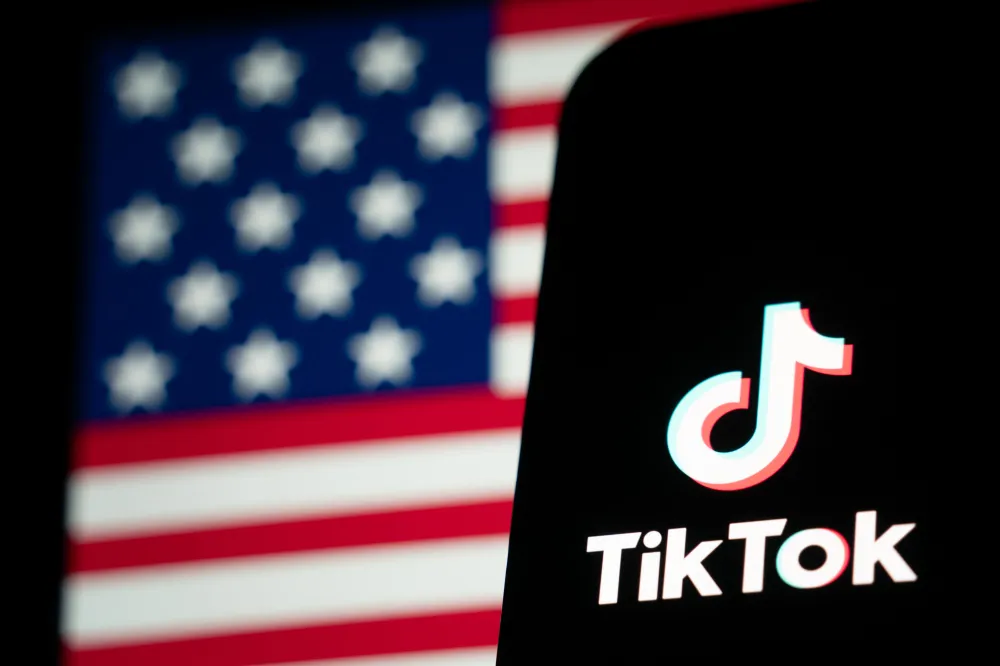The advent of AI image generators has brought a surprising innovation to the ever-evolving entity of artificial intelligence in the world of content creators, designers, and industries alike-they are basically superior tools in generating images from text. They will completely transform the content creation process as we know it. In 2025, the demand for high-quality, customizable, and accessible AI images is booming more than ever. In the realm of possible choices, absolutely free AI image generators are the best possible way to decide matters for anyone looking for great tools for a great price. This allows potential users of the technology to climb the ladder without a monetary commitment.
At Great American, we appreciate the primordial aspect of tools that balance performance against expense. Because each graphic designer at home will appreciate higher quality of work shortly, AI image generation will be superlative toward that end. Graphic designers or Marketer-aesthetes can explore the polished visuals of those AI image generators today, or persons foraying into the AI field now have a wide range of options to choose from regarding AI images. Users can feed their favorite images with plain text and let the program generate professional-grade images with as much quality and speed as any of the traditional methods.
Needless to say, the importance of this technology goes beyond providing solutions. It extends to basic access of technologies to develop advanced image technology, rendering a more equal ground for either individual operators or smaller organizations. From simple image generation to higher-level versions, these generators work with all levels of skills and project requirements. As many of them have become more popular in the hour, these platforms bestow several upgraded image models and features, further pushing the limits of the possibilities of digital art creation.
Deep inside the emerging AI image generation industry, it is evident that these tools are giving birth to the whole new paradigm concerning how we think of, and hence produce, visual content. More than being just in a place where the best visual arts industry, the best free AI image generators are essentially cutting-edge; the technology allows serious wiggle rooms for creative expression over an enormous breadth of realms and applications.
The Best AI Image Generators and Overview
Nothing remains dormant, and no one person can possibly write that. AI image generators have expanded to a modern diverse set of tools. There are different accessible kinds of AI image generators for every need and desire, and among the favorites available consider some among those that shine in performance and uniqueness. DALL-E will remain outstanding by OpenAI as the oldest in the generation of images from textual descriptions, also through its newest creations; it is capable of producing photorealistic images from exceptionally complex text descriptions. Its very features make it suitable for professional-grade projects needing precision and sophistication; ingenious algorithms can pick up on nuanced prompts.
Adobe Firefly, another contender in the whole AI-generated image arena, is just a click away from the already familiar creative suite provided by Adobe. Aside from being available for commercial-safe images while preserving quality artistry, this is also best for businesses and marketing practitioners who are evaluating copyright-safe usage for their images. Canva’s AI image generator is designed with an interface that can be learned by even users with no experience; it combines super AI power with good design tools, making sophisticated images available to everyone.
The Bing Image Creator from Microsoft is a part of the Microsoft Designer line and is known for its bringing together some broad productivity tools with image generation that create pictures one would have no need to change in any way or form to fit into the Microsoft ecosystem of applications. Craiyon, which was originally called DALL-E mini, is now more popular because it is fast in generation and simple in methodology, which make it an excellent choice for prototyping or quick experimentation. Leonardo AI, as its name reflects, focuses mainly on generating games assets and 3D models. It thus appeals particularly to game developers and digital artists who work in immersive environments.
In the past, the image-making capabilities of Meta AI improved drastically. The production of images stems much from the company’s in-depth research in machine learning, making the context of these pictures to an impressive level. The proposition of Generative AI by Getty Images is indeed interesting in that it wants every generated content to be compliant with commercial usage standards. This would take care of common worries about licensing and rights management surrounding images. DreamStudio provides a very finely tuned interface for users to customize generation of images closely, so one can have reasonable control and tweaking of output.
Other notable mentions include Ideogram, which specializes in generating images with text elements, and Reve, known for its ability to create highly realistic portraits and character designs. Recraft focuses on crafting detailed illustrations and concept art, while NightCafe offers a community-driven approach to AI art creation. Pixlr combines traditional photo editing tools with AI-powered enhancements, creating a versatile platform for both beginners and experienced designers. Each of these generators brings something unique to the table, whether it’s specialized functionality, ease of use, or integration capabilities, making them valuable tools in any creator’s arsenal.
When evaluating the best AI image generators, it’s crucial to consider factors such as image quality, customization options, processing speed, and specific use-case suitability. Many of these platforms now offer both free and premium tiers, allowing users to experiment with basic features before committing to more advanced capabilities. The diversity of available options ensures that regardless of your specific needs from simple image generation to complex, detailed artwork there’s likely an AI image generator that can meet and exceed your expectations.
How Do AI Image Generators Work?
The AI image generator is a sophisticated neural network that develops on millions or billions of images within the context of data. It is usually based on a modified diffusion model or generative adversarial networks (GANs) to present an image based on the respective text description. The bad part comes, when the user carks out a text prompt, through the simple, straightforward, to some more complicated, multi-part narratives including elements and instructions on style.
Unveiling the Magic Behind Text-to-Image Conversion
Here, the AI image generator needs to train or analyze textual input for its first NLP-based task. Further breaking that down, it identifies those prompt elements like main objects, relationships, styles, and maybe, ventures like contextual cues. Next generation models like GPT-3o and offspring have been top-notch in this semantic comprehension step where they basically can also capture those fine-grained nuances and implications from the text. Once the model completes the analysis, the next step involves translation of these text cues into corresponding visual features using its trained knowledge base of image-text pairing.
During such image generation, the artificial intelligence undergoes multi-step procedures and gives adjustments gradually to the final output. The system begins with some white random noise, then subjected to some denoising steps on diffusion models such as the Stable Diffusion where it processes it into coherent images. In each iteration, the output would become even more detailed and accurate because of the input prompting, whereby elements of the text-to-image model are matched with appropriate attention mechanisms. The model has to interpolate on training data to come up with appropriate color palettes, textures, light conditions, and compositions that give rise to the described event.
Customization options in modern AI image generators allow the users to influence different facets of the generation process. Style strength, aspect ratio, and artistic interpretation are among the many parameters that can be adjusted during this process. Some other platforms also provide for additional control in specifying angles from which an image is photographed, thus making it more individualized in image generation. The fact that this system can tackle the most sophisticated imaging prompts and use multi-parts tells you the significant amount of versatility it has, given that it was trained on extremely diverse datasets virtually covering all imaginable image variety.
The final stage involves post-processing and refinement, where the AI applies finishing touches to enhance image quality and coherence. This may include upscaling techniques to improve resolution, color correction for aesthetic consistency, and detail enhancement to ensure clarity and realism. The entire process, from initial text input to final image output, demonstrates how AI image generators work to bridge the gap between imagination and visualization, enabling users to automatically create images that previously required extensive manual effort and expertise.
Why Are AI Images So Weird Sometimes?
Despite their remarkable capabilities, AI image generators occasionally produce results that appear strange or unexpected, revealing fascinating insights into the current limitations of artificial intelligence in visual creation. One primary reason for these peculiar outcomes lies in the inherent challenges of matching complex text prompts with visual representations. While AI models are trained on vast datasets containing millions of images, they sometimes struggle to accurately interpret abstract concepts, idiomatic expressions, or culturally specific references. This limitation can lead to surreal combinations where elements are present but arranged in unconventional ways, resulting in images that feel simultaneously familiar and bizarre.
Exploring the Quirks of Automated Art
Technical constraints also contribute significantly to the weirdness factor in AI-generated images. The diffusion process, which forms the backbone of many modern image generators, works by gradually transforming random noise into structured patterns. During this transformation, small errors or misinterpretations can compound, leading to artifacts or distortions in the final output. Hands and faces, in particular, pose challenges for AI systems due to their complexity and the critical role they play in human perception. When these elements go awry, perhaps manifesting as extra fingers or distorted facial features, it creates an uncanny effect that draws immediate attention.
Another factor contributing to unusual AI images relates to the statistical nature of machine learning models. These systems generate outputs based on probability distributions learned from their training data, meaning they tend to favor common patterns while struggling with rare or novel combinations. When presented with unique or highly specific prompts, the AI might default to more general interpretations or blend elements in unexpected ways. This tendency can result in images that contain all requested elements but arrange them in ways that defy logical spatial relationships or physical laws.
The phenomenon of “hallucination” in AI image generation further explains some of the weird outputs. Similar to how language models sometimes generate plausible-sounding but factually incorrect information, image generators can create details that weren’t explicitly requested or that contradict the given prompt. These hallucinations might manifest as impossible architectural structures, floating objects, or inconsistent lighting effects that break the illusion of reality. Additionally, the compression and abstraction processes involved in training data preparation can lead to characteristic artifacts or stylistic quirks that become amplified during image synthesis.
User expectations also play a crucial role in perceiving AI-generated images as weird. Humans possess deep contextual understanding and cultural awareness that AI systems haven’t fully replicated. While an AI might technically satisfy a prompt’s requirements, the result can still feel off because it lacks the intuitive understanding of social norms, artistic conventions, or practical considerations that humans naturally incorporate into their creations. This disconnect between technical accuracy and human perception often manifests in images that are technically correct but aesthetically jarring or conceptually mismatched.
What Makes the Best AI Image Generator?
Identifying the best AI image generator requires a careful consideration of all important factors that distinguish above-platforms from just workable ones. Image quality stands out on this list; this term encompasses resolution as well as full coherence and realism of every generated image. The best generators capable of producing results, from beginning to end, in high fidelity, maintaining sharp detail, proportional accuracy, and realistic textures for all subjects and styles. Ideally, this quality must remain relevant no matter the complexity of your prompt or what specifics are being generated, from a vast landscape with many subtleties to an individual character design.
Key Features and Considerations
Customizability offered ranks next as another major distinguishing factor among AI image generators. The best platforms afford users fine control over any number of variables, including style transfer intensity, aspect ratio, color palette choice, and artistic interpretation. Advanced customization options might entail adjusting lighting parameters, depth of field, and artistic filters, enabling the user to fine-tune the image in such a way. Customizing the elements pertinent to each artwork or the freedom to introduce iterative refinement demonstrates great sophistication and versatility. Probably especially valuable are utilities that let users exercise some control over parts of the intermediate steps rather than merely dictating the end result.
Ease of use is vital, especially in terms of how generators serve nontechnical users. The best generators afford a delicate balance between powerful functionality and intuitive interface such that novices and professionals alike can effectively reach their intended outcome. This involves having readily accessible documentation, messages with error feedback that are instructive, and clever suggestions to walk the user through the creation procedure. Integrating one’s existing workflows and tools also go a long way in making for better usability, allowing for AI-generated images to be smoothly introduced into a larger application, either for creative or business purposes.
Performance considerations such as generation speed and resource efficiency rank in their own right. The best generators get the job done in the least possible time without compromising quality, frequently providing some real-time previews or quick iterations. Equally, the best ones exhibit stability and reliability, maintaining a relatively high uptime with very few errors or failures. Their ability to stand delivery of complex prompts while crash-proofing or avoiding timing out is a measure of its robustness and readiness for professional purposes.
Other factors would include ethical considerations pertaining to transparent licensing, responsible content generation, etc. The best AI image generation platforms respect fair use, provide clear attribution guidelines for generated content, and maintain mechanisms to filter out harmful content, thus demonstrating their commitment to responsible AI development. Furthermore, active communities, regular updates, and responsive support teams contribute to a generator’s overall value proposition, ensuring that users receive ongoing support and benefit from continuous improvements to the platform’s capabilities.
Can AI Image Generators Make Money?
The commercial potential of AI image generators extends far beyond simple image creation, presenting numerous viable pathways for generating revenue across various industries. For freelance designers and digital artists, these tools serve as powerful assistants that dramatically increase productivity while reducing time spent on repetitive tasks. By leveraging AI image generators to handle preliminary drafts, background elements, or complex pattern creation, professionals can take on more projects simultaneously, effectively scaling their operations without sacrificing quality. Many successful creators have reported increasing their output by 50% or more while maintaining premium pricing, thanks to the enhanced efficiency provided by AI assistance.
Exploring Commercial Opportunities and Business Models
AI image generators offer significant cost-saving opportunities in marketing and advertising departments. Companies traditionally reliant on expensive stock photography subscriptions or custom photography shoots can now generate bespoke images tailored precisely to their brand identity and campaign requirements. This capability proves particularly valuable for e-commerce platforms, where product imagery needs frequent updates or variations. Some retailers have reported reducing their visual content production costs by up to 70% while simultaneously improving conversion rates through more engaging, customized product visuals.
The service-based monetization model represents another lucrative avenue, with many entrepreneurs building successful businesses around AI image generation. Some have created subscription-based platforms offering specialized image creation services for niche markets, such as architectural visualization or fashion design. Others have developed white-label solutions for agencies and corporations, providing customized AI image generation capabilities integrated directly into client workflows. These service providers often combine multiple AI models to offer hybrid solutions that address specific industry needs, charging premium rates for their expertise and implementation services.
Content creators and influencers have found innovative ways to leverage AI image generators for monetization through sponsored content and affiliate marketing. By producing high-quality, AI-assisted visuals for promotional campaigns, they can secure higher sponsorship rates while maintaining complete control over their creative output. Some have even developed proprietary templates and style presets that they license to fellow creators, creating additional revenue streams from their AI-enhanced workflows. The ability to quickly generate visually striking content for social media platforms has proven particularly valuable, enabling creators to maintain consistent posting schedules and engage larger audiences.
Educational institutions and training organizations have also discovered profitable applications for AI image generators. By developing comprehensive courses and workshops teaching effective AI image generation techniques, they cater to the growing demand for digital skills training. Some have created certification programs that validate proficiency in using various AI tools, charging premium rates for both individual learners and corporate clients seeking workforce upskilling. The educational sector’s adoption of AI image generators demonstrates how these tools can create entirely new markets while enhancing traditional learning methodologies.
Perhaps most significantly, AI image generators enable entirely new business models centered around personalized content creation. Companies specializing in custom merchandise, interior design visualization, or virtual try-on experiences can leverage AI to offer hyper-personalized products and services at scale. This capability allows them to charge premium prices while maintaining efficient production processes, creating a competitive advantage in increasingly crowded markets. The combination of AI-powered image generation with other emerging technologies like augmented reality and 3D modeling opens even more possibilities for innovative business ventures built around visual content creation.
How We Test Image App Performance
Our comprehensive and well-thought-out testing methodology for AI image generators employs a multi-dimensional performance measurement framework. We set up standardized test scenarios covering almost all conditions, from simple tasks such as image generation to much more complex tasks, with multi-elements composition. Objective and subjective measurements are included in these test cases to create a good balance in assessing most aspects of the platform. The measurement on quantitative analysis will include the generation time, the resource consumption, and the success rate across prompt complexities as key performance indicators. The controlled testing environment is replicated with hardware and network conditions to eradicate any outside factors that could result in deviations from the test outcomes.
Evaluating AI Image Generators with Precision
Image quality will be assessed using a combination of automated metrics and expert review panels. Automated assessments will include the established benchmarks such as Structural Similarity Index Measure (SSIM), Peak Signal-to-Noise Ratio (PSNR), and Fréchet Inception Distance (FID) methodology that objectively measure technical aspects of image fidelity. As mentioned previously, we note limitations of relying solely on numbers. Thus, we countercheck these metrics extracted from qualitative review panels with those conducted using professional artists and design experts. Such a dual approach goes beyond the other measures and finds subtle distinctions between images that may not be easily captured through an automated system, such as artistic coherence, balanced composition, and emotional impact.
Test of custom capability involves varying the input parameters to their full range systematically. We evaluate how each generator handles requests for specific styles, restrictions on color palettes, and constrained compositions. We also venture with some edge cases and hard prompts to prodding what’s the limit of each platform’s possibilities. Herewith are the assessment criteria for customization: beyond parameter modification to new advanced features like iterative refinement, element isolation and style transfer accuracy.
User experience assessments will be on the technical performance and convenience of use regarding interface design. We include interaction metrics, such as task completion time, error rate, and discoverability of features, in user testing sessions of participants across different skill levels. This gives us an insight on how well both novices and experienced professionals fit into the offering of each platform. Focus will also be included in the quality of documentation, handling of errors, and resources, as all impact time of use significantly in adoption.
Integration testing examines how well each AI image generator works within broader creative workflows. This includes evaluating API performance, compatibility with industry-standard software, and ability to handle batch processing tasks. We simulate real-world production scenarios to assess stability under heavy workloads and measure how well each platform scales with increasing demands. Our testing protocol also includes security assessments and data privacy evaluations to ensure platforms meet contemporary standards for protecting user information and intellectual property.
Finally, we conduct longitudinal studies to monitor platform stability and improvement over time. This involves tracking update frequency, bug resolution times, and feature development pace. We maintain detailed performance logs for each platform, allowing us to identify trends and patterns in reliability and capability growth. This comprehensive approach ensures our evaluations reflect not just current performance but also potential for future development and sustained quality.
Best AI Image Tools for Beginners in 2025
For starters in AI image production, the best tools make a lot of difference between having a seamless learning curve and being satisfied with results. Among the easier options, Canva is quite scopeful for its simple drag-and-drop interface but with AI capability. The step-by-step guided workflows provide the user with the whole process of creating an image, while the library of templates offers great starting points from which to work with the different projects. And with its real-time preview, any change done on them can easily be identified by a beginner seeing how the image changes as an adjustment is happening, thus offering a hands-on experience towards confidence and competence development.
NightCafe is another good entry-level application for most extreme beginners. It is mostly used for those who want to explore different art styles. Its very simplified interface organizes all the essential controls in such a way so as not to drown the users in so many options too early. This history gallery serves as an inspiration and an education within the community by showing what meaningful prompts can do and what can be achieved using different settings. For the free tier, NightCafe comes with generous limits to usage, thereby allowing extensive indulgence for experimentation without putting too much in the pocket while the newbies develop this skill and understanding of principles behind AI image generation.
Pixlr stands for that ideal level in between photo editing and AI creation, making it an appropriate place for beginners moving away from traditional design tools. It keeps to editing paradigms that are known while gradually introducing more features that are enhanced with AI. At the end of the day, built-in tutorials and interactive guides teach people both fundamental design concepts as well as the principles of design with AI. But Pixlr has a mobile app version where all these things can be accessed even as a beginner practices on the go without losing sync with what has been accomplished on the desktop.
It has a specific advantage for new gamers and 3D asset generation. It looks quite advanced, but the platform’s organized methodology in AI image generation makes all the multifaceted tasks easy for beginners. The preset arrangements for common use cases, along with the elucidation of how each setting affects the final result, help beginners in understanding what those technical concepts mean without losing them in detail. Its approach motivates iterative refinements to spur experimentation and learning by doing.
The best part about Craiyon (formerly known as DALL-E mini) is that it’s wholly text to image; that is, devoid of any technical barriers, making it easy for beginners to engage themselves in the process of crafting prompts and seeing the results by themselves. Generation time is brisk, making for lots of quick iteration, and there’s a public gallery with some enlightening insights from which one can learn about how different prompts manifest into pictures. Simplicity need not detract from the pedagogical value; predictable behavior will help beginners get enough foundation on the fundamentals of AI image generation before getting into more complex tools.
All of these individual beginner-friendly platforms differ in some ways but closely share certain similarities that make them stand out: clear documentation, effective methods of customer support, as well as lively communities imparting experience and allowing the general public to learn from each other. They are those that provide the right balance between low learning curve and high power; in short, they make it possible for beginners to do meaningful work while leveling up their skills for the top features.
The Best AI Image Generators at a Glance
What occurs in the assessment of the spreading pages comprising AI image generators is that every single technology showcases some things or the other within its realms of operation, coupled with the uniqueness exhibited in meeting the requirements of specific users. While OpenAI’s DALL-E can be applauded for high ratings on scoring excessively complicated and multi-layered prompts as per its accuracy, it strongly embraces an ability to produce highly detailed images with elements maintained in a contextual coherence that is especially delimited for use in precision ambition in professional-grade projects. Recent updates on the platform in subsection-about spatial relationships and lighting conditions bring forth more naturally photographed-like presentations than normal photography quality.
The real genius of attracting dimension is opened through probable platforms like DreamStudio based on Stable Diffusion. Through functionality, unconfined from all restrictive image generators, it tweaks everything and defines such things including denoising steps or such-specific artistic styles. This kinks anything advanced into a fine bottleneck for virtuosic steerage while learning, making it harder for non-habitual users. Updates continue to be churned out as there are innovations and changes to the community-structured development approach of the platform, assuring that it continues to keep the line broad at the forefront of artificial intelligence image-generation technology.
Adobe Firefly stands out by integrating into the established creative ecosystem of Adobe, making it a great choice for professionals who have already made an investment in this software suite. This product value proposition has an artistic presentation for commercially safe images, thus addressing potential issues related to licensing and usage rights. With an easy interface and familiar paradigms designers have been used to over the years, entry barriers for traditional designers shifting into an AI-assisted workflow have been lowered. The platform’s enterprise-appropriate security and compliance features also make it attractive to Michael-level entities and huge marketing teams.
Deep integration with its set of productivity tools and Microsoft’s cloud infrastructure offers real benefits to using Bing Image Creator. As part of the broader Microsoft Designer suite, this picture generator has sorely won on creating boardroom-type images that perfectly align with corporate branding guidelines and the aesthetics of an office suite. The ability of this generator to comprehend and implement through understanding particular business requirements strengthens the generator in terms of the value it adds as it is paired with an enterprise-level support and scalability. Emphasis on features around collaboration and team-based workflows further augments this value proposition for use cases within organizations.
It’s quite amazing that the AI image generator of Canva literally has a different mode of working: it caters to accessibility and ease of use and produces surprisingly superior results. The strength of its democratization lies in accessing advanced image creation which can successfully enable all users without a formal design training to come up with professional high-quality visuals. Well-resourced template libraries and guided workflows are there to ensure you overcome the commonplace creative barriers as real time previewing functionality allows immediate and precise adjustment or feedback for uplifting the processing time. For instances of casual users and small firms that search for budget-efficient alternatives, Canva is proven to be a better choice since it has this freemium model along with cross-platform availability.
Other interesting sites include the likes of Leonardo AI, which really focuses on the kind of assets for games and the specific production of 3D models even outsources DIY optimized workflows and features for certain industries, exemplifying how the AI image generators can be modified to serve specific professional communities. Ideogram is not among the only platforms that target certain phenomena for users; Getty Images, for instance, has its Generative AI platform as an enterprise answer to demands for licensed and rights-managed content.
The AI image generators are very diversified that share common spaces with general-purpose tools beside specialized solutions for particular niches. While some are emphasizing raw power and flexibility, the others are ease in the capability of integration or relative to industry requirements. Thus, this ensures that no matter how varied are the specifications thrown at an AI image generator-from basic image generation to the most complex, multi-faceted projects-there exists one that can meet and, indeed, exceed them.
AI Image Generators and Architecture, Capabilities, and Applications
AI image generators represent a sophisticated class of artificial intelligence systems specifically designed to transform textual descriptions or visual prompts into coherent, high-quality images. At their core, these generators utilize complex neural network architectures, typically variants of diffusion models or generative adversarial networks (GANs), trained on vast datasets containing millions of image-text pairs. This extensive training enables them to understand and replicate diverse visual styles, compositions, and artistic tech. The capabilities of modern AI image generator techniques, making them invaluable tools for both creative professionals and casual users alike.
Advanced platforms can interpret nuanced prompts containing multiple elements, relationships, and stylistic instructions, producing images that demonstrate remarkable contextual awareness. For instance, they can generate images that accurately depict specific historical periods, architectural styles, or cultural contexts while maintaining technical accuracy and artistic coherence. Many generators now support multimodal inputs, allowing users to combine text descriptions with reference images or sketches, resulting in more precise and controlled outputs.
These tools find application across numerous industries and use cases. In marketing and advertising, AI image generators enable rapid creation of campaign materials, product visualizations, and social media content, significantly reducing production time and costs. Design professionals leverage these tools for prototyping, mood boards, and early-stage concept development, while game developers use them to generate assets, environments, and character designs. The fashion industry utilizes AI image generators for trend forecasting, collection planning, and virtual try-on experiences, while architects and interior designers employ them for space visualization and material exploration.
Recent advancements have introduced features that further enhance the versatility of AI image generators. Many platforms now offer specialized modes for different types of content creation, such as photorealistic rendering, artistic interpretation, or technical illustration. Upscaling capabilities allow users to increase image resolution without losing quality, while style transfer functions enable consistent branding across multiple assets. Some generators incorporate physics simulations and lighting calculations to produce more realistic and technically accurate results, particularly valuable for scientific visualization and engineering applications.
The integration of AI image generators with other technologies has opened new possibilities for interactive and immersive experiences. Real-time generation capabilities enable live demonstrations and collaborative creation sessions, while compatibility with augmented reality and virtual reality platforms facilitates spatial visualization and environmental design. Cloud-based implementations ensure accessibility across devices and locations, supporting remote collaboration and distributed teams. These technological developments, combined with ongoing improvements in algorithm efficiency and training methodologies, continue to expand the scope and impact of AI image generation across various professional domains and creative disciplines.
Qwen: Alibaba’s Versatile AI Image Generation Solution
Qwen represents Alibaba’s comprehensive approach to AI image generation, offering a robust platform that balances technical sophistication with user accessibility. The system’s architecture leverages advanced transformer-based models trained on an extensive dataset of image-text pairs, enabling it to interpret complex prompts with remarkable accuracy. Unlike many other AI image generators, Qwen demonstrates particular strength in understanding Chinese cultural contexts and linguistic nuances, making it especially valuable for projects targeting Asian markets or requiring specific cultural sensitivity.
One of Qwen’s distinguishing features is its multimodal input capability, allowing users to combine text descriptions with reference images, sketches, or style guides. This flexibility enables more precise control over the generation process, particularly beneficial for projects requiring consistent branding or specific artistic direction. The platform’s batch processing functionality supports efficient creation of image sets, while its API integration capabilities facilitate seamless incorporation into existing workflows and enterprise systems. Qwen’s performance metrics indicate generation speeds that rival market leaders, with response times averaging under five seconds for standard resolutions.
The platform’s customization options extend beyond basic style and composition adjustments, offering advanced controls for lighting conditions, perspective angles, and material properties. These granular settings prove particularly valuable for product visualization and architectural rendering, where technical accuracy is paramount. Qwen’s recent updates have enhanced its ability to generate complex scenes with multiple interacting elements, demonstrating improved understanding of spatial relationships and environmental context. The system’s error handling and fallback mechanisms ensure reliable performance even with challenging prompts, while its scalable infrastructure supports enterprise-grade deployment requirements.
DALL-E (OpenAI): Pioneering Precision in AI Image Generation
DALL-E, developed by OpenAI, stands as a landmark achievement in AI image generation technology, renowned for its ability to transform complex textual descriptions into visually stunning and contextually accurate images. The latest iteration of DALL-E demonstrates remarkable advancements in several key areas, particularly in its sophisticated understanding of spatial relationships, lighting dynamics, and compositional elements. Unlike earlier versions, the current model can accurately interpret and execute multi-part prompts that require precise arrangement of elements, maintaining coherence across various visual components while respecting specified stylistic constraints.
One of DALL-E’s most notable strengths lies in its exceptional handling of detailed image generation tasks. The system excels at creating images that require technical accuracy alongside artistic expression, such as architectural renderings, product designs, or scientific visualizations. Its advanced diffusion model architecture enables the generation of images with unprecedented clarity and definition, while sophisticated attention mechanisms ensure proper alignment between text elements and visual components. Recent updates have significantly improved the model’s ability to handle complex lighting scenarios, material properties, and environmental interactions, resulting in more realistic and technically sound outputs.
The platform’s customization capabilities represent another area of significant advancement. Users can now specify exact camera angles, depth of field effects, and precise color palettes through intuitive controls that don’t require technical expertise. DALL-E’s implementation of iterative refinement allows creators to build upon initial results, making incremental adjustments that cumulatively enhance the final image. The system’s ability to maintain consistency across multiple generations proves particularly valuable for projects requiring cohesive visual identities or sequential storytelling elements. Additionally, DALL-E’s robust API integration facilitates seamless incorporation into professional workflows, enabling automation of repetitive tasks and scaling of production capabilities without compromising quality.
Stable Diffusion: Revolutionizing Accessible AI Image Creation
Stable Diffusion represents a groundbreaking advancement in AI image generation, distinguished primarily by its open-source architecture and unparalleled flexibility. Unlike many proprietary systems, this platform provides users with complete access to its underlying codebase and model weights, enabling unprecedented levels of customization and innovation. The system’s diffusion-based architecture operates through a progressive denoising process, transforming random noise into coherent images through iterative refinement steps. This approach, combined with its modular design, allows developers and researchers to modify and extend the system’s capabilities according to specific project requirements.
The platform’s customization options set it apart from other AI image generators, offering users precise control over numerous generation parameters. Through its web-based interface and command-line tools, creators can adjust denoising steps, sampling methods, and guidance scales with remarkable granularity. Advanced users can implement custom training pipelines, fine-tune models on specialized datasets, or develop unique plugins that extend the system’s functionality. This flexibility has led to the emergence of numerous community-driven forks and extensions, each tailored to specific artistic styles or technical requirements.
Performance-wise, Stable Diffusion demonstrates impressive efficiency, capable of generating high-resolution images on consumer-grade hardware. Its optimized memory management and parallel processing capabilities enable faster generation times compared to many closed-source alternatives, while maintaining comparable image quality. The platform’s ability to run locally gives users greater control over their data and privacy, addressing common concerns about cloud-based solutions. Recent community contributions have introduced features such as inpainting, outpainting, and image-to-image translation capabilities, further expanding its creative potential.
The ecosystem surrounding Stable Diffusion continues to evolve rapidly, with active development of companion tools and integrations. Projects like Automatic1111’s WebUI and ComfyUI provide user-friendly interfaces that simplify access to advanced features, while maintaining the system’s core flexibility. The platform’s compatibility with various hardware accelerators and its support for mixed-precision computation make it accessible to users with different technical setups. This combination of power, flexibility, and accessibility has positioned Stable Diffusion as a preferred choice for both professional creators and hobbyists seeking to explore the frontiers of AI-assisted art creation.
Adobe Firefly: Elevating Professional Creativity with AI-Powered Imaging
Adobe Firefly represents a paradigm shift in professional creative workflows, seamlessly integrating advanced AI image generation capabilities into Adobe’s established ecosystem of creative tools. Unlike many standalone AI image generators, Firefly operates within a comprehensive framework that includes Photoshop, Illustrator, and other Adobe applications, enabling unprecedented synergy between traditional design methods and AI-assisted creation. This integration manifests through features like Generative Fill, which allows designers to intelligently expand canvas areas or fill selections with AI-generated content that matches surrounding elements, maintaining perfect continuity in complex compositions.
The platform’s strength lies in its ability to generate commercially safe images while preserving artistic integrity, addressing major concerns about licensing and usage rights that plague many other AI image generators. Firefly’s training data consists exclusively of Adobe Stock images and other legally acquired resources, ensuring that generated content complies with copyright regulations. This commitment to legal compliance extends to its output, with each generated image carrying clear usage rights information, making it particularly valuable for professional projects requiring strict adherence to intellectual property laws.
Performance-wise, Firefly delivers exceptional results through its sophisticated understanding of design principles and artistic techniques. The system excels at interpreting complex design briefs, translating technical specifications into visually compelling compositions that demonstrate remarkable attention to detail. Its ability to maintain consistent branding elements across multiple generations proves invaluable for corporate identity projects and marketing campaigns. Recent updates have enhanced its understanding of typography, enabling precise placement and styling of text elements within generated images, while maintaining readability and visual hierarchy.
Customization options in Firefly extend beyond basic style and composition adjustments, offering advanced controls for material properties, lighting conditions, and environmental interactions. The platform’s integration with Adobe’s Sensei AI framework enables real-time style transfer, allowing users to apply specific artistic treatments or maintain brand-consistent aesthetics across multiple assets. Firefly’s cloud-based architecture ensures seamless collaboration and version control, while its API integration capabilities facilitate automation of repetitive tasks and scaling of production workflows without compromising quality or creative control.
Canva: Democratizing Design with AI-Powered Image Creation
Canva’s AI image generator represents a significant evolution in accessible design tools, seamlessly integrating advanced artificial intelligence capabilities with the platform’s renowned user-friendly interface. The system’s strength lies in its ability to transform complex design tasks into intuitive, guided experiences that empower users of all skill levels to create professional-quality visuals. Through its AI Design Assistant, Canva interprets natural language prompts and translates them into sophisticated design elements, while maintaining consistency with established design principles and brand guidelines.
The platform’s performance characteristics demonstrate remarkable efficiency in generating high-quality images across various use cases. Canva’s AI engine processes requests rapidly, typically delivering results within seconds while maintaining image fidelity and composition integrity. Its smart object recognition capabilities enable automatic cropping, resizing, and positioning of elements, ensuring optimal layout regardless of output format. The system’s adaptive learning algorithms continuously refine their understanding of user preferences and design trends, resulting in increasingly relevant and aesthetically pleasing suggestions over time.
Customization options in Canva’s AI image generator extend far beyond basic style adjustments, offering granular control over numerous design parameters through an intuitive interface. Users can specify exact color palettes, typography choices, and composition rules while benefiting from AI-powered recommendations that suggest optimal combinations based on current design trends and proven visual hierarchies. The platform’s extensive library of templates and design assets integrates seamlessly with AI-generated elements, enabling users to create cohesive visual identities across multiple formats and channels.
Performance optimization remains a core focus of Canva’s AI implementation, with the system employing advanced caching mechanisms and distributed processing to ensure consistent response times even during peak usage periods. Its cloud-based architecture enables real-time collaboration and automatic version control, while sophisticated error handling protocols prevent disruptions during the creative process. The platform’s API integration capabilities facilitate connection with third-party tools and enterprise systems, extending its functionality beyond simple image generation to encompass comprehensive brand management and marketing automation workflows.
Bing Image Creator (Microsoft Designer): Enterprise-Grade AI Image Generation
Bing Image Creator, integrated within Microsoft’s broader Designer suite, represents a sophisticated solution for enterprise-level image generation needs. The platform’s architecture leverages Microsoft’s extensive Azure infrastructure, ensuring reliable performance and enterprise-grade security protocols while delivering AI-powered image creation capabilities. Unlike many consumer-focused AI image generators, Bing Image Creator emphasizes seamless integration with Microsoft’s productivity ecosystem, including Teams, SharePoint, and PowerPoint, facilitating streamlined workflows across organizational departments.
The system’s performance characteristics demonstrate remarkable consistency in generating high-quality images optimized for professional presentations and marketing materials. Bing Image Creator processes requests efficiently, typically delivering results within three to five seconds for standard resolutions, while maintaining image fidelity across various output formats. Its advanced understanding of corporate branding guidelines enables precise control over color schemes, typography, and composition elements, ensuring generated images align perfectly with organizational identity standards. The platform’s Smart Composition feature automatically adjusts layouts based on content type and intended use case, optimizing visual impact while maintaining technical accuracy.
Customization options extend beyond basic style adjustments, offering granular control over numerous parameters through an intuitive interface that aligns with Microsoft’s familiar design paradigms. Users can specify exact aspect ratios, resolution requirements, and file formats while benefiting from AI-powered recommendations that suggest optimal visual treatments based on project context. The platform’s Template Intelligence feature analyzes existing corporate materials to generate images that maintain consistent styling and messaging, proving particularly valuable for maintaining brand coherence across multiple communications channels.
Enterprise-specific features include robust access control mechanisms, role-based permissions, and comprehensive audit trails for all generated content. The system’s integration with Microsoft Information Protection ensures sensitive data remains secure throughout the creation process, while its compliance with industry standards like GDPR and HIPAA makes it suitable for regulated industries. Bing Image Creator’s API capabilities enable seamless incorporation into existing enterprise workflows, supporting automation of repetitive tasks and scaling of production capabilities without compromising quality or security.
Craiyon (formerly DALL-E mini): Rapid Prototyping with Accessible AI
Craiyon, formerly known as DALL-E mini, represents a unique position in the AI image generation landscape by offering rapid prototyping capabilities through its streamlined architecture. Unlike its more resource-intensive counterparts, Craiyon maintains a lightweight model structure that enables swift image generation while preserving sufficient quality for conceptual exploration and quick iterations. The platform’s performance metrics demonstrate consistent response times averaging two to three seconds for basic image generation tasks, making it particularly valuable for brainstorming sessions and initial design phases where speed outweighs absolute fidelity.
The system’s strength lies in its ability to interpret straightforward prompts efficiently, translating simple text descriptions into visual representations that capture essential elements without demanding complex parameter adjustments. While it may lack the sophisticated customization options of larger models, Craiyon excels at generating multiple variations quickly, allowing users to explore different creative directions with minimal time investment. Recent optimizations have improved its understanding of basic composition principles and color theory, resulting in more coherent outputs that maintain recognizable relationships between described elements.
Customization options in Craiyon focus on practical adjustments that enhance usability without overwhelming users with technical complexity. The platform offers basic controls for style preferences, aspect ratios, and image quality settings, catering to users who need quick results rather than precise artistic control. Its batch generation capability enables simultaneous creation of multiple image variations, proving particularly useful for A/B testing different visual approaches or gathering stakeholder feedback on various concepts. The system’s web-based interface ensures accessibility across devices while maintaining responsive performance even during peak usage periods.
Despite its relative simplicity, Craiyon maintains robust error handling protocols that prevent disruptions during the creative process, while its community-driven development model ensures regular updates and feature enhancements. The platform’s public gallery serves as both inspiration and educational resource, demonstrating how different prompts translate into visual results and helping users refine their description techniques. This combination of speed, accessibility, and reliability makes Craiyon an excellent choice for users seeking efficient prototyping capabilities without the complexity of more advanced systems.
Meta AI: Advancing Multimodal Creativity with Seamless Integration
Meta AI’s image generation capabilities represent a significant leap forward in multimodal content creation, leveraging the company’s extensive research in machine learning and natural language processing. Unlike many standalone AI image generators, Meta AI integrates seamlessly with its broader ecosystem of tools and platforms, enabling users to create, edit, and share visual content across multiple formats and devices. This integration extends beyond simple image generation to encompass video, audio, and text elements, creating a unified creative environment that supports complex multimedia projects.
The platform’s performance characteristics demonstrate remarkable versatility in handling various types of prompts and inputs. Meta AI excels at interpreting nuanced instructions that combine textual descriptions with visual references, allowing users to guide the generation process through mixed media inputs. Its advanced understanding of contextual relationships enables the system to maintain coherence across multiple elements while respecting specified stylistic constraints. Recent updates have significantly improved the model’s ability to handle dynamic compositions, resulting in more fluid and naturalistic outputs that rival traditional animation techniques.
Customization options in Meta AI extend far beyond basic style and composition adjustments, offering granular control over numerous parameters through an intuitive interface. Users can specify exact timing sequences, transition effects, and synchronization points while benefiting from AI-powered recommendations that suggest optimal combinations based on project requirements. The platform’s Timeline Intelligence feature analyzes existing multimedia assets to generate images that maintain consistent styling and messaging across different formats, proving particularly valuable for maintaining brand coherence across various communication channels.
Enterprise-specific features include robust collaboration tools, real-time editing capabilities, and comprehensive version control for all generated content. The system’s integration with Meta’s Horizon Workrooms and other virtual collaboration environments ensures seamless teamwork and feedback loops, while its compliance with industry standards makes it suitable for regulated industries. Meta AI’s API capabilities enable seamless incorporation into existing enterprise workflows, supporting automation of repetitive tasks and scaling of production capabilities without compromising quality or security.
Performance optimization remains a core focus of Meta AI’s implementation, with the system employing advanced caching mechanisms and distributed processing to ensure consistent response times even during peak usage periods. Its cloud-based architecture enables real-time collaboration and automatic version control, while sophisticated error handling protocols prevent disruptions during the creative process. The platform’s extensive library of templates and design assets integrates seamlessly with AI-generated elements, enabling users to create cohesive visual identities across multiple formats and channels while maintaining technical accuracy and artistic integrity.
Generative AI by Getty: Ensuring Commercial Safety in AI Image Creation
Getty Images’ Generative AI platform represents a pioneering approach to AI-powered image creation within the context of strict commercial licensing requirements. Unlike many other AI image generators, this platform operates under rigorous content governance protocols, ensuring that all generated images meet the highest standards of legal compliance and intellectual property protection. The system’s training data consists exclusively of Getty Images’ vast repository of rights-managed content, providing users with absolute assurance regarding the commercial safety of their creations.
The platform’s performance characteristics demonstrate exceptional reliability in generating high-quality images optimized for professional use cases. Getty’s AI engine processes requests efficiently, typically delivering results within five to seven seconds while maintaining image fidelity across various output formats. Its sophisticated understanding of copyright law and licensing agreements enables precise control over usage rights, with each generated image carrying clear documentation of permissible applications. The system’s Rights Management Engine automatically applies appropriate licenses and usage restrictions, streamlining the approval process for commercial projects.
Customization options in Getty’s Generative AI extend beyond basic style adjustments, offering granular control over numerous parameters through an intuitive interface designed specifically for professional users. Creators can specify exact licensing terms, usage durations, and distribution channels while benefiting from AI-powered recommendations that suggest optimal visual treatments based on intended application. The platform’s Brand Compliance feature analyzes existing corporate guidelines to generate images that maintain consistent styling and messaging across different marketing channels, proving particularly valuable for maintaining brand coherence while adhering to legal requirements.
Enterprise-specific features include robust access control mechanisms, role-based permissions, and comprehensive audit trails for all generated content. The system’s integration with Getty Images’ existing digital asset management infrastructure ensures seamless workflow integration and automated rights management, while its compliance with international copyright laws makes it suitable for global marketing campaigns. Getty’s API capabilities enable connection with third-party tools and enterprise systems, extending its functionality beyond simple image generation to encompass comprehensive brand management and marketing automation workflows.
Performance optimization remains a core focus of Getty’s AI implementation, with the system employing advanced caching mechanisms and distributed processing to ensure consistent response times even during peak usage periods. Its cloud-based architecture enables real-time collaboration and automatic version control, while sophisticated error handling protocols prevent disruptions during the creative process. The platform’s extensive library of licensed assets integrates seamlessly with AI-generated elements, enabling users to create commercially safe visuals across multiple formats and channels while maintaining technical accuracy and artistic integrity.
DreamStudio: Precision Control in AI-Powered Image Creation
DreamStudio represents a paradigm shift in AI image generation, offering unprecedented levels of control and customization through its sophisticated parameter adjustment capabilities. Unlike many other AI image generators that prioritize ease of use over precision, DreamStudio provides users with granular control over every aspect of the generation process, from initial noise patterns to final post-processing effects. This level of detail-oriented control proves particularly valuable for professional artists and designers who require exacting standards in their creative work.
The platform’s architecture employs advanced diffusion models combined with proprietary refinement algorithms that enable iterative improvement of image quality. Users can adjust denoising steps with precision increments, modify sampling methods through customizable schedules, and fine-tune guidance scales with remarkable accuracy. Recent enhancements have introduced adaptive resolution scaling, allowing creators to maintain image fidelity across different output sizes while preserving intricate details and complex textures. The system’s Layered Control System enables independent manipulation of foreground and background elements, ensuring perfect compositional balance and spatial relationships.
Performance characteristics demonstrate exceptional consistency in generating high-quality images optimized for professional applications. DreamStudio’s Optimized Processing Pipeline delivers results within competitive timeframes while maintaining superior image quality across various resolutions and aspect ratios. Its Advanced Artifact Reduction technology minimizes common issues like color bleeding, aliasing, and texture repetition, resulting in cleaner outputs that require minimal post-processing. The platform’s Batch Rendering capability allows simultaneous generation of multiple variations with specific parameter sets, proving invaluable for A/B testing different creative approaches or exploring alternative design directions.
Customization options extend far beyond basic style adjustments, offering specialized controls for lighting conditions, material properties, and environmental interactions. The platform’s Material Physics Engine accurately simulates real-world surface behaviors, enabling precise control over reflections, refractions, and subsurface scattering effects. DreamStudio’s Dynamic Lighting System allows users to position and adjust light sources with surgical precision, creating realistic shadow patterns and highlight distributions that enhance three-dimensional depth perception. The system’s Color Harmony Analyzer suggests optimal palette combinations based on established color theory principles, while its Composition Advisor ensures proper alignment of visual elements according to classical artistic rules.
Enterprise-specific features include robust version control mechanisms, collaborative workspace environments, and comprehensive project management tools. The system’s integrated Asset Library enables efficient organization and reuse of frequently used elements, while its Template System facilitates rapid deployment of standardized designs across multiple projects. DreamStudio’s API capabilities support seamless integration with existing creative workflows and enterprise systems, enabling automation of repetitive tasks and scaling of production capabilities without compromising quality or creative control. The platform’s Security Framework ensures protected handling of sensitive content, with enterprise-grade encryption and access control protocols safeguarding intellectual property throughout the creation process.
Ideogram: Mastering Text-Image Integration in AI Generation
Ideogram distinguishes itself in the AI image generation landscape through its specialized focus on seamless text-image integration, addressing one of the most challenging aspects of automated visual creation. Unlike general-purpose image generators that often struggle with accurate text placement and readability, Ideogram employs advanced typography-aware algorithms that ensure precise alignment between textual elements and visual compositions. This expertise proves particularly valuable for projects requiring clear communication through both imagery and written content, such as marketing materials, instructional graphics, and branded content.
The platform’s architecture incorporates a dedicated Text Understanding Module that analyzes linguistic structures alongside visual contexts, enabling sophisticated placement decisions that consider both aesthetic appeal and functional requirements. Ideogram’s proprietary Font Matching System automatically selects appropriate typefaces based on project tone, brand guidelines, and readability considerations, while its Dynamic Scaling Technology adjusts text size and spacing to maintain optimal legibility across different resolutions and viewing distances. Recent updates have enhanced its ability to handle multilingual content, supporting complex character sets and right-to-left scripts with remarkable accuracy.
Performance characteristics demonstrate exceptional consistency in generating high-quality images that effectively combine text and visual elements. Ideogram’s Intelligent Layout Engine processes requests efficiently, typically delivering results within four to six seconds while maintaining perfect alignment between textual and graphical components. Its Advanced Kerning Adjustment feature ensures proper spacing between characters, while the Paragraph Flow Optimization system maintains coherent text blocks within complex compositions. The platform’s Readability Analysis tool evaluates contrast ratios, font weights, and background interference to guarantee maximum comprehension regardless of viewing conditions.
Customization options extend beyond basic style adjustments, offering specialized controls for typographic hierarchy, text wrapping behavior, and alignment preferences. Users can specify exact line heights, letter spacings, and paragraph indents while benefiting from AI-powered recommendations that suggest optimal typographic treatments based on project context. Ideogram’s Brand Typography Manager enables organizations to enforce consistent font usage across multiple assets, while its Style Inheritance System ensures proper application of corporate identity standards to all generated content. The platform’s Text Effects Library provides access to sophisticated treatments like shadows, glows, and gradients that enhance visual impact without compromising readability.
Enterprise-specific features include robust localization capabilities, multilingual project management tools, and comprehensive brand governance frameworks. The system’s Translation Integration Module supports seamless incorporation of translated content, automatically adjusting layouts to accommodate varying text lengths while maintaining design integrity. Ideogram’s API capabilities facilitate connection with content management systems and marketing automation platforms, enabling efficient production of localized materials across different regions and languages. The platform’s Security Protocols ensure protected handling of sensitive information, with enterprise-grade encryption and access control mechanisms safeguarding confidential content throughout the creation process.
Reve: Revolutionizing Portrait and Character Design with AI Precision
Reve represents a groundbreaking advancement in AI-powered portrait and character generation, specializing in creating hyper-realistic human representations with unprecedented accuracy and emotional depth. Unlike general-purpose image generators that often struggle with facial anatomy and expression authenticity, Reve employs sophisticated biometric modeling and emotion recognition algorithms that ensure anatomically correct features while capturing subtle nuances of human expression. This specialization proves particularly valuable for applications ranging from character design in entertainment media to personalized marketing materials and virtual avatar creation.
The platform’s architecture incorporates an advanced Facial Structure Analysis System that maps over 200 distinct facial landmarks, enabling precise control over proportions, symmetry, and unique identifying features. Reve’s proprietary Emotion Synthesis Engine interprets complex emotional cues from text prompts, translating them into corresponding facial expressions that demonstrate remarkable authenticity. Recent enhancements have significantly improved the system’s ability to handle diverse ethnicities, age ranges, and gender presentations, resulting in more inclusive and representative outputs that reflect global populations accurately.
Performance characteristics demonstrate exceptional consistency in generating high-quality portraits optimized for various applications. Reve’s Optimized Rendering Pipeline delivers results within competitive timeframes while maintaining superior image quality across different resolutions and styles. Its Advanced Skin Texture Simulation technology creates realistic surface details, including pores, wrinkles, and blemishes, while its Hair Generation System produces natural-looking strands with accurate lighting interactions and movement dynamics. The platform’s Real-Time Preview feature allows users to observe incremental changes and make precise adjustments to achieve desired results efficiently.
Customization options extend far beyond basic appearance adjustments, offering specialized controls for facial structure, expression intensity, and environmental interaction. Users can specify exact bone structures, muscle definitions, and skin properties while benefiting from AI-powered recommendations that suggest optimal combinations based on intended application. Reve’s Pose Control System enables precise positioning of characters within scenes, while its Lighting Integration Module ensures proper interaction between artificial illumination and human features. The platform’s Expression Library provides access to hundreds of predefined emotional states, allowing quick experimentation with different moods and attitudes.
Enterprise-specific features include robust character management tools, collaborative workspace environments, and comprehensive project tracking systems. The system’s Character Consistency Engine ensures uniform appearance across multiple assets, while its Animation Ready Export function prepares models for immediate use in various production pipelines. Reve’s API capabilities support seamless integration with existing creative workflows and enterprise systems, enabling automation of repetitive tasks and scaling of production capabilities without compromising quality or creative control. The platform’s Security Framework ensures protected handling of sensitive content, particularly important when generating realistic human likenesses that may be used in secure environments or for sensitive applications.
Recraft: Elevating Illustration and Concept Art with AI Precision
Recraft stands out as a specialized AI image generator tailored for illustrators and concept artists, offering tools that bridge traditional art techniques with cutting-edge AI technology. Unlike general-purpose image generators, Recraft focuses on delivering high-quality illustrations and concept art that maintain artistic integrity while leveraging the efficiency of AI-powered workflows. This makes it an invaluable tool for professionals in industries such as gaming, film, publishing, and advertising, where detailed and stylistically consistent visuals are paramount.
The platform’s architecture incorporates a proprietary Artistic Style Engine that analyzes and replicates various illustration techniques, from hand-drawn sketches to digital paintings. Recraft’s Layered Composition System allows users to build complex artworks in stages, mimicking traditional layering methods while benefiting from AI-driven precision. Recent updates have introduced advanced brush simulation technology, enabling the creation of textures and strokes that closely resemble those produced by physical media. This level of detail extends to material properties, with accurate rendering of ink, watercolor, oil paint, and other mediums.
Performance characteristics demonstrate exceptional consistency in generating high-quality illustrations optimized for professional use cases. Recraft’s Adaptive Rendering Pipeline processes requests efficiently, typically delivering results within five to eight seconds while maintaining superior image fidelity across different styles and resolutions. Its Smart Perspective Tool ensures proper alignment of elements within scenes, while the Dynamic Lighting Module creates realistic interactions between artificial illumination and surface materials. The platform’s Iterative Refinement feature allows users to make incremental adjustments, enhancing details and refining compositions without starting from scratch.
Customization options extend far beyond basic style adjustments, offering specialized controls for line weight, texture density, and color palettes. Users can specify exact brushstroke patterns, shading techniques, and composition rules while benefiting from AI-powered recommendations that suggest optimal combinations based on project context. Recraft’s Style Transfer System enables seamless integration of specific artistic treatments, allowing creators to maintain brand-consistent aesthetics across multiple assets. The platform’s Asset Library provides access to thousands of predefined elements, including character templates, environmental assets, and decorative motifs, streamlining the creative process.
Enterprise-specific features include robust collaboration tools, version control mechanisms, and comprehensive project management systems. The system’s Workflow Automation Module supports batch processing of repetitive tasks, while its Integration API enables connection with third-party design tools and enterprise systems. Recraft’s Security Protocols ensure protected handling of sensitive intellectual property, with enterprise-grade encryption and access control mechanisms safeguarding confidential content throughout the creation process. Additionally, the platform’s Compliance Framework ensures adherence to industry standards and legal requirements, making it suitable for regulated industries and large-scale projects.
NightCafe: Community-Driven Creativity in AI Image Generation
NightCafe represents a unique approach to AI image generation, emphasizing community engagement and collaborative creativity alongside powerful image creation capabilities. Unlike many standalone AI generators that focus solely on individual user experiences, NightCafe fosters a vibrant ecosystem where creators can share, collaborate, and learn from one another’s work. This community-driven model not only enhances the creative process but also accelerates skill development and innovation within the platform.
The platform’s architecture combines advanced diffusion models with social networking features, creating a dynamic environment where users can explore diverse artistic styles and techniques. NightCafe’s Gallery System showcases user-generated content, providing valuable inspiration and educational resources for new creators. Its Trend Analysis Engine identifies emerging styles and popular techniques, offering users insights into current design trends while suggesting innovative approaches to their own projects. Recent updates have introduced collaborative creation tools that allow multiple users to contribute to a single artwork, blending different styles and perspectives seamlessly.
Performance characteristics demonstrate remarkable efficiency in generating high-quality images while maintaining responsive interaction with community features. NightCafe’s Optimized Processing Pipeline delivers results within competitive timeframes, typically completing standard resolutions in three to five seconds. Its Smart Suggestion System analyzes user preferences and browsing history to recommend complementary styles and techniques, enhancing the creative exploration process. The platform’s Real-Time Feedback feature allows users to receive immediate input from peers and experts, facilitating rapid iteration and improvement of their work.
Customization options extend beyond basic style adjustments, offering specialized controls for artistic direction, composition elements, and technical parameters. Users can specify exact color schemes, texture densities, and lighting conditions while benefiting from AI-powered recommendations that suggest optimal combinations based on project requirements. NightCafe’s Style Fusion Technology enables blending of different artistic influences, creating unique hybrid styles that push creative boundaries. The platform’s Template Library provides access to thousands of predefined compositions, while its Preset System allows users to save and share their favorite configurations with the community.
Enterprise-specific features include robust collaboration tools, project management systems, and comprehensive analytics dashboards. The system’s Team Workspace Module supports efficient organization of group projects, while its Integration API enables connection with existing creative workflows and enterprise systems. NightCafe’s Security Framework ensures protected handling of sensitive content, with enterprise-grade encryption and access control mechanisms safeguarding intellectual property throughout the creation process. Additionally, the platform’s Monetization Options allow creators to earn revenue from their work through licensing agreements and commissioned projects, fostering a sustainable creative economy within the community.
Pixlr: Bridging Traditional Editing with AI-Powered Enhancement
Pixlr represents a significant evolution in photo editing tools by seamlessly integrating AI-powered enhancements with traditional editing capabilities. Unlike pure AI image generators or conventional photo editors, Pixlr offers a hybrid solution that combines the best of both worlds, empowering users to leverage advanced artificial intelligence while maintaining precise manual control over their edits. This dual approach proves particularly valuable for professional photographers, graphic designers, and content creators who require both automated efficiency and hands-on craftsmanship in their workflow.
The platform’s architecture incorporates a sophisticated AI Assistant that works in tandem with traditional editing tools, analyzing images and suggesting optimal adjustments based on content type and intended use case. Pixlr’s Smart Editing System employs machine learning algorithms to automatically detect and correct common issues like exposure imbalance, color casts, and perspective distortion, while still allowing users to fine-tune these corrections manually. Recent updates have introduced advanced object recognition capabilities that enable precise selection and manipulation of specific elements within complex compositions, significantly reducing the time required for detailed editing tasks.
Performance characteristics demonstrate exceptional consistency in delivering high-quality results across various editing scenarios. Pixlr’s Optimized Processing Engine handles complex operations efficiently, maintaining smooth performance even during intensive tasks like batch processing or high-resolution editing. Its Adaptive Resolution Technology ensures optimal image quality regardless of output format, while the platform’s Non-Destructive Editing System preserves original image data throughout the editing process. The system’s Real-Time Preview feature allows users to observe changes instantly, facilitating rapid experimentation and refinement of visual effects.
Customization options extend far beyond basic adjustment sliders, offering specialized controls for advanced editing techniques and artistic treatments. Users can specify exact color grading profiles, create custom filter presets, and define complex masking rules while benefiting from AI-powered recommendations that suggest optimal combinations based on project context. Pixlr’s Layer Management System enables sophisticated compositing and blending effects, while its Effects Library provides access to hundreds of predefined treatments that can be customized and saved for future use. The platform’s Batch Processing Module automates repetitive tasks across multiple images, ensuring consistent application of edits while maintaining individual file integrity.
Enterprise-specific features include robust asset management tools, collaborative workspace environments, and comprehensive project tracking systems. The system’s Brand Consistency Engine ensures uniform application of corporate identity standards across multiple assets, while its Integration API enables seamless connection with existing creative workflows and enterprise systems. Pixlr’s Security Protocols ensure protected handling of sensitive content, with enterprise-grade encryption and access control mechanisms safeguarding confidential intellectual property throughout the editing process. Additionally, the platform’s Version Control System maintains complete revision histories, allowing users to track changes and revert to previous states as needed.
Other AI Image Generators: Exploring Niche Innovations and Specialized Solutions
Beyond the major players in the AI image generation landscape, numerous specialized platforms cater to specific niches and use cases, each bringing unique innovations to the table. Midjourney, for instance, has gained significant traction among artists and creatives for its ability to generate highly artistic and visually striking images that often transcend traditional aesthetic boundaries. Its strength lies in interpreting abstract concepts and translating them into surreal, dreamlike visuals that challenge conventional artistic norms while maintaining technical sophistication.
Runway ML represents another innovative approach, focusing on video and motion graphics alongside still image generation. Their multimodal capabilities enable seamless transitions between different media formats, allowing users to create cohesive multimedia projects within a single platform. The system’s real-time collaboration features and extensive plugin ecosystem make it particularly valuable for teams working on complex productions requiring synchronized visual elements across various formats.
DeepArt and DeepDream Generator specialize in transforming photographs into artworks inspired by famous painting styles, employing neural style transfer techniques that produce remarkably authentic artistic interpretations. These platforms excel at preserving the structural integrity of original images while applying sophisticated artistic filters that mimic the brushstrokes and color palettes of renowned artists. Their recent advancements in temporal coherence have improved the consistency of style application across sequences, making them increasingly valuable for video processing and animation projects.
Artbreeder takes a different approach by emphasizing evolutionary image creation through genetic algorithms. Users can blend and mutate existing images to create new variations, exploring vast possibility spaces through intuitive slider interfaces. This methodology proves particularly effective for character design, environment creation, and iterative concept development, allowing creators to organically evolve their ideas through gradual refinement rather than starting from scratch with each iteration.
Photoleap focuses exclusively on photo editing and enhancement, employing AI-powered tools specifically designed for mobile photography. Its portrait retouching capabilities rival professional-grade desktop software, while its automated scene optimization features help amateur photographers achieve professional-looking results with minimal effort. The platform’s cloud-sync functionality ensures seamless workflow continuity across devices, making it an excellent choice for content creators who frequently switch between mobile and desktop environments.
Each of these specialized platforms demonstrates how AI image generators can address specific needs and use cases beyond general-purpose solutions. Whether focusing on particular artistic styles, media formats, or editing techniques, these niche innovations continue to expand the boundaries of what’s possible in digital image creation, offering users more precise tools for realizing their creative visions.
Engaging with the Future of AI Image Generation
Great American, we understand that staying informed about the rapidly evolving landscape of AI image generators is crucial for professionals, enthusiasts, and businesses alike. Our dedicated team of experts and researchers continuously monitors developments across the AI image generation ecosystem, providing timely insights and analysis through our comprehensive news platform. Whether you’re seeking information about the latest technological breakthroughs, practical implementation strategies, or emerging market trends, our editorial team is committed to delivering accurate, actionable content that helps you navigate this transformative field effectively.
We invite readers to engage with our platform through multiple channels, ensuring you never miss critical updates or opportunities to enhance your understanding of AI image generation technologies. Subscribe to our newsletter for curated weekly digests featuring expert analysis, product reviews, and industry news. Follow us on social media platforms where we host regular Q&A sessions, live demonstrations, and interactive discussions with leading experts in the field. For organizations seeking deeper insights or customized research, our enterprise solutions team offers tailored consulting services and market intelligence reports that address specific business needs and strategic objectives.
Our commitment extends beyond mere information dissemination; we actively foster a community of practice around AI image generation technologies. Through our online forums and discussion groups, users can share experiences, exchange ideas, and collaborate on projects that push the boundaries of what’s possible with these powerful tools. We regularly host virtual events and webinars featuring thought leaders from academia, industry, and creative fields, providing unique opportunities to learn from pioneers shaping the future of AI-powered visual creation.
For media inquiries, partnership opportunities, or suggestions regarding content coverage, our editorial team welcomes direct communication through our contact portal. We value feedback from our readership and incorporate community input into our content strategy to ensure we address the most pressing questions and emerging trends in the AI image generation space. Whether you’re a seasoned professional seeking advanced technical insights or a newcomer looking to understand the basics of AI-powered image creation, Greatamerican.ai serves as your comprehensive resource for navigating this exciting and rapidly evolving field.















